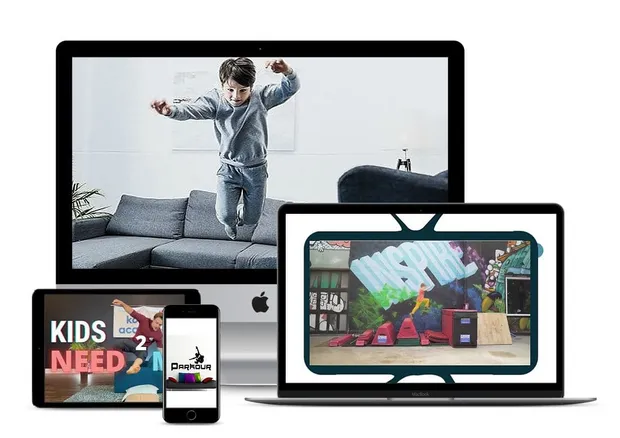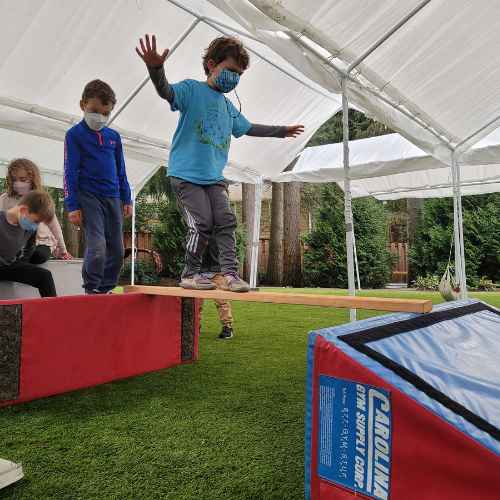
Finding the right balance between screen time and active play is crucial for children’s development and overall health. Movement breaks are an effective way to reduce screen time and ensure that kids are engaging their bodies and minds. These breaks involve short bursts of physical activity that interrupt the sedentary nature of screen-based activities like playing video games or using a computer. By integrating movement breaks into your child’s daily routine, you can help maintain their physical wellness, improve their mood, and enhance their focus.
What Is A Movement Break & Why Are They Important?
Movement breaks are brief periods dedicated to physical activity, designed to re-energize and refocus children’s minds. Incorporating activities like pushing, pulling, lifting, and climbing engages children’s muscles, dramatically enhancing their alertness and readiness to learn.
The importance of movement breaks extends beyond mental alertness, as they also contribute to physical health and emotional well-being. Regular physical activity helps manage stress, boost mood, and improve overall fitness. Additionally, heavy muscle work often recommended during these breaks can also enhance fine motor skills and body awareness, making them an essential component of a healthy daily routine for kids.
The Science Behind Movement Breaks
Understanding The Power And Science Behind Movement Breaks
The effectiveness of movement breaks, commonly referred to as ‘brain breaks,’ is grounded in their ability to enhance both cognitive function and socio-emotional health. Movement breaks are a strategic tool that can enhance your child’s cognitive function and socio-emotional health. Research shows that these breaks significantly improve productivity, creativity, and concentration for students. Let’s explore how.
Cognitive Benefits that Make Learning Stick
Movement breaks stimulate physical activity, increasing blood flow and oxygen to the brain – essential ingredients for maintaining sharp, active cognitive functions. This physical stimulation helps your child consolidate memories and make connections between learned concepts, making learning more effective and long-lasting. In fact, a study found that academic performance improved by 9% in assessments conducted after physical exercise.
Boosting Socioemotional Well-Being
Physical activity and time outdoors can help your child manage stress and maintain their energy levels. Movement breaks also encourage social interactions, which are vital for developing empathy and reducing feelings of isolation among peers. In school environments, where resources and opportunities can be limited, these breaks can be a low-cost, high-impact way to support your child’s overall well-being.
As a parent, understanding the science behind movement breaks empowers you to integrate them into your child’s daily routine, setting them up for success in learning and life.
The Negative Effects Of Too Much Screen Time

Source: Screen Time Management Strategy Guide for Parents – Circle
Excessive screen time has emerged as a significant concern, particularly in the context of children’s development. While digital devices play an integral role in modern life, the overuse of such technology can lead to several detrimental effects on mental, physical, and emotional health.
Mental Effects
Studies have consistently shown that prolonged screen time can impair children’s attention spans and contribute to poor sleep patterns. The blue light from screens can interfere with the natural sleep-wake cycle, resulting in sleep disruptions that impact overall health and cognitive performance. Additionally, the instant gratification provided by digital interactions can foster addictive behaviors. This can make it difficult for children to engage deeply and persistently with tasks that require sustained attention.
Physical Effects
Physically, excessive screen time often correlates with a sedentary lifestyle, which can contribute to obesity and other health issues. Children who spend considerable time engaged in screen-based activities are likely missing out on essential physical activities that are critical for healthy growth and development. Furthermore, the posture adopted during screen use can lead to musculoskeletal problems, including neck and back pain.
Emotional Effects
On the emotional front, high levels of screen time have been linked to increased rates of anxiety and depression among children. The constant flow of notifications and the pressures of social media can create a relentless demand for attention that overwhelms young minds. Social skills can also suffer, as screen time often replaces face-to-face interactions with peers and family. This leads to isolation and a lack of necessary emotional development.
Overall Implications
The blend of these effects underscores the need for balanced screen time. As a parent or educator, you should monitor and limit the use of screens. This ensures that kids have ample opportunities to engage in physical play, face-to-face interactions, and activities that do not involve digital devices.
By setting structured limits and encouraging alternative activities, you can help mitigate the negative impacts of excessive screen time. This approach can also quickly promote a healthier, more balanced lifestyle for children.
Productive Screen Time Vs Passive Screen Time
Understanding the difference between productive and passive screen time can greatly enhance how children interact with digital media. It can quickly turn potential drawbacks into beneficial experiences.
Productive Screen Time
Productive screen time involves activities that engage the brain actively and often have an educational or developmental purpose. This type of screen use is interactive and enriches the user, promoting learning, problem-solving, and active participation.
For example, Kong Academy Can Make Screen Time More Fun, Active And Healthier:
- Underwater Adventure Brain Break
16 Min 🐋 Underwater Adventure Brain Break | Kids Summer Workout and Movement Exercises
Floor Is Lava Brain Break
15 Min Floor is Lava Kids Brain Break | Full Lava Monster, King Moltar & Phoenix Adventure
Passive Screen Time
In contrast, passive screen time is characterized by non-interactive consumption of content, such as watching random YouTube videos or playing non-educational video games. These activities require minimal mental engagement and physical activity. They often lead to prolonged periods of sitting which can contribute to a sedentary lifestyle. While passive screen time can be relaxing and entertaining, it does little to stimulate the mind or body. It can quickly become a habit-forming activity that displaces time that could be spent on more enriching tasks.
Tips For Parents To Encourage More Movement Breaks
Incorporating movement breaks into a child’s day is essential for balancing screen time and promoting physical activity. Here are several strategies parents can use to ensure their kids are getting enough movement and less passive screen time:
1. Set Reminders and Alarms
Utilize technology to your advantage by setting reminders or alarms during longer screen time sessions. These can serve as cues for your child to take a break and move around. For instance, after every 30 minutes of screen time, an alarm could signal a five-minute movement break where kids can stretch, do jumping jacks, or any quick activity that gets the blood flowing.
2. Create “Tech-Free” Zones
Establish areas in the home where technology is not allowed, such as the dining room or bedrooms. These zones encourage physical activity and personal interaction, reducing the overall time spent on screens. This also helps children associate certain areas with movement and play rather than screen time.
3. Make New Habits
Integrate movement breaks into daily routines to make them habitual. For example, after finishing homework or before dinner time, you could encourage a habit where your child engages in physical activity as a strategy to calm down. Consistently linking screen time with movement can help establish a natural rhythm and balance between sedentary and active periods.
Balancing screen time with physical activity is crucial for children’s health. Introducing movement breaks can significantly offset the negative impacts of excessive screen use and sedentary behavior. By establishing tech-free zones and participating in physical activities as a family, you can quickly encourage a healthy and active lifestyle for your children.
Interested in making screen time more educational and physically engaging for your child? Contact Kong Academy to discover brain break programs and how you can help your child thrive in a digital world while staying healthy!
GET Access to the ULTIMATE PLAY DATE PACKAGE (Value: $49) for FREE!


7-Day Crystal Shard Adventure
Unleash your child’s potential with our 7-day crystal shard movement adventure!




